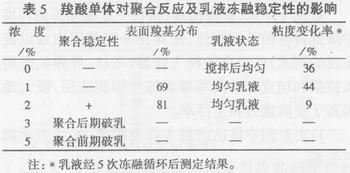Development of freeze-thaw resistant polyvinyl acetate emulsion adhesive
2.3 Surface carboxyl groups

When the carboxylic acid monomer is added to the system, due to the difference in the reactivity ratio, on the one hand, the polymerization rate may be adjusted to affect the stability of the polymerization reaction, and on the other hand, the monomer is copolymerized, and part of the carboxyl groups are distributed in the latex particles. Surface, increase the stability of emulsion particles [5]. It can be seen from Table 5 that when the acid content is 1%, the emulsion polymerization is stable. When the acid content is increased to 2%, agglomerates are slightly formed on the paddle, and most of the carboxyl groups are distributed on the surface. When the acid content is higher than 3%, phase separation occurs in the emulsion polymerization process. The emulsion breaks the emulsion and the polymerization does not proceed normally. In this system, the appropriate acid concentration is ≤ 2% if added before the reaction. When the acid concentration was 1% and 2%, the distribution of surface carboxyl groups was not changed, and the emulsion freeze-thaw stability was improved.
2.4 Basic properties of emulsion
By selecting the types of emulsifiers and buffers and copolymerizing with unsaturated carboxylic acid monomers, a suitable protective colloid was selected to synthesize a freeze-thaw poly vinyl acetate emulsion adhesive. The basic properties are shown in Table 6. The emulsion can be restored to its original state after 5 cycles of freezing and thawing and frozen at -20°C for 6 months, and its basic performance is unchanged.

3 Conclusion
The freeze-thaw stability of 3.1 VAc/BA emulsions is related to emulsifiers, protective colloids, and buffers. The non-ionic emulsifier OP-10 is beneficial to the emulsion freeze-thaw stability, but in order to ensure emulsion polymerization stability, a small amount of anionic emulsifier SDS must be added, and the suitable ratio is OP-10/SDS=2-5/1; in PVA1788/1799 = 1/1 is NaAc 0.2% emulsion freeze-thaw stability for the protective colloid system, and 1.0-2.0% Na2HPO4 emulsion is used for freeze-thaw stabilization in the PVA 1788 system. Different types of buffers in different protective colloid systems The effects of freeze-thaw stability are different.
3.2 When a functional monomer containing a carboxyl group is introduced into the emulsion system, part of the carboxyl groups are distributed on the surface of the latex particles, and the freeze-thaw stability of the emulsion can be improved.
3.3 The synthesized copolymer emulsion can be reconstituted after 5 freeze-thaw cycles and freeze at -20°C for 6 months. It still has fluidity at 0°C, and the wood-wood compression shear strength can reach 12MPa or more before and after freeze-thaw cycles. Excellent overall performance of the emulsion adhesive.
(Author/Liu Xiaohui, Liu Haiying, Yan Limei, Li Xin, Zhao Ying
Heilongjiang Institute of Petroleum Chemistry
Furniture,Outdoor Furniture,Chair Furniture,Office Furniture
NINGBO CHEN WEI SUPPLY CHAIN MANAGEMENT CO.,LTD , https://www.nbchenweifurniture.com